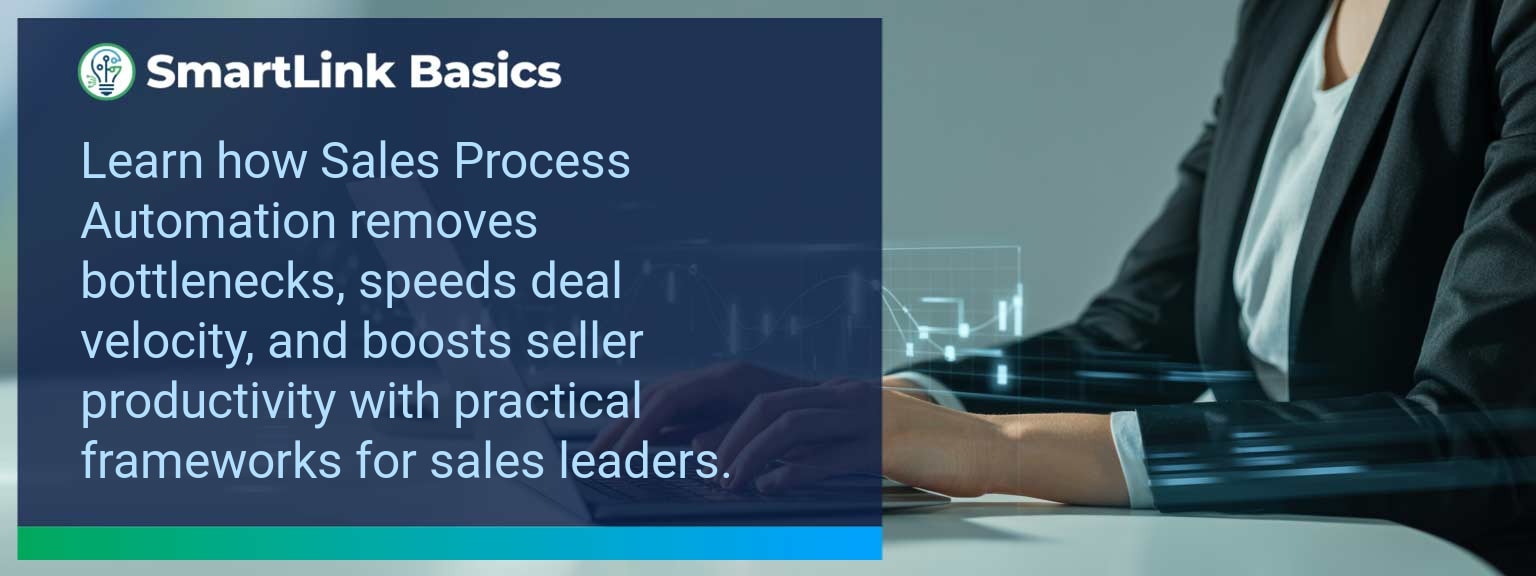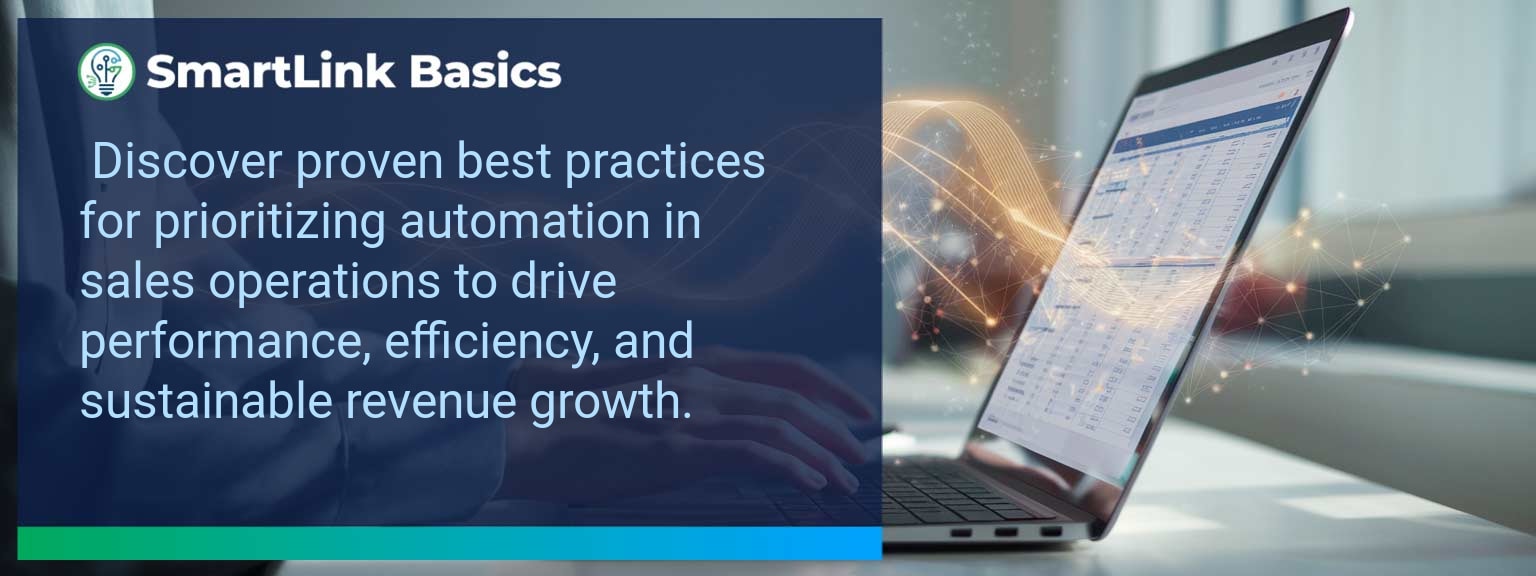Industry data shows that organizations adopting AI-driven automation achieve cost reductions of up to 30% while accelerating sales cycles by 20% or more (McKinsey, 2024). For sales leaders, AI automated workflows now define competitive advantage, enabling teams to reallocate time from repetitive tasks to high-value engagements. At SmartLink Basics, we help decision-makers implement these systems strategically, ensuring they integrate with existing revenue operations. In this article, you’ll see how AI automated workflows power business outcomes, the common obstacles that slow adoption, and practical steps to optimize processes. You’ll walk away with proven examples, a 90-day action blueprint, and measurable KPIs to track results.
- Automate repetitive administrative and CRM updates with AI.
- Integrate machine learning to personalize outreach at scale.
- Streamline approvals, quotes, and contract workflows for speed.
- Use predictive analytics to prioritize sales opportunities.
- Track adoption and performance with targeted metrics.
AI Automated Workflows: What Changed and Why It Matters
AI adoption has shifted from experimental to operational, making automated workflows a standard in high-performing sales organizations. The real advantage lies in combining workflow automation with artificial intelligence workflows to optimize every step of the revenue process. Sales leaders now use AI to synchronize touchpoints, reduce manual inputs, and ensure faster execution. For example, a B2B SaaS leader introduced automated lead enrichment and routing, cutting qualification time by 60%. Actionable insight: Audit processes for time-intensive handoffs and apply AI where repeatability is high.Redesign the Revenue Operating System With AI Automated Workflows
ICP, Segmentation, and Targeting AI-enabled segmentation uses historical wins, firmographic, and behavioral data to dynamically update ICP profiles. This ensures targeting precision without quarterly re-work. Pipeline Architecture Automated workflows push opportunities through the right stages based on engagement signals. AI flags at-risk deals for intervention. Plays and Messaging Integrated automation tools deliver personalized sequences based on buyer activity, increasing relevance at every touchpoint. Operating Cadence AI schedules follow-ups, forecast calls, and account reviews based on actual pipeline movement rather than static calendars. Actionable insight: Implement automation that adapts in real-time to both internal and buyer-driven events.Common Obstacles To Achieving Seamless Automation
The most frequent challenges are fragmented systems, inconsistent data quality, and cultural resistance. Without a unified data layer, automation amplifies errors rather than solving them. Coca-Cola Europacific Partners reported needing a full data governance upgrade before AI could improve sales workflows. Leaders must first assess infrastructure readiness and train teams to trust AI-influenced recommendations. Actionable insight: Before deployment, establish clean data practices and a single source of truth.Implementing AI To Optimize Workflows
Effective deployment of AI process optimization starts with mapping current-state processes, identifying friction points, and matching them with automation tools. For example, automating proposal generation based on CRM opportunity data can reduce turnaround from three days to one hour. Solutions combining business process automation platforms with machine learning integration enable continuous performance improvement. Actionable insight: Pilot in one high-impact stage, measure, and then expand.Tangible Benefits From Automated Processes
The benefits extend beyond time savings — sales leaders gain a scalable system. Tangible outcomes include faster quote-to-close, higher lead conversion, and better forecast accuracy. A manufacturing firm implemented AI-assisted order processing and cut errors by 40%, improving on-time delivery rates. Actionable insight: Track both speed and accuracy to measure workflow automation effectiveness.Metrics That Matter
| Category | Metric | Definition | Target |
|---|---|---|---|
| Leading | Workflow Completion Rate | % of automated sequences executed without manual intervention | 95%+ |
| Leading | AI Suggestion Adoption Rate | % of AI-generated action recommendations executed by reps | 80%+ |
| Lagging | Cycle Time Reduction | Decrease in time from lead entry to closed-won | 20%+ |
| Lagging | Revenue Per Rep | Average sales revenue generated per sales rep per quarter | +15% YoY |
| Quality | Automation Error Rate | % of workflows that trigger incorrect outcomes | <1% |
| Quality | Customer Satisfaction Post-Automation | Average CSAT score after automation implementation | ≥ 4.5/5 |
Innovations And Next Steps For AI Automation
Emerging capabilities like AI-generated playbooks, intent-driven dynamic routing, and integrated AR for virtual product demos are shaping the next wave of sales automation. Companies integrating these tools early will outpace competitors in speed and personalization. Actionable insight: Stay ahead by testing emerging automation features quarterly and aligning them with evolving buyer expectations.Get the 90-day plan, coaching rubric, and dashboard template to operationalize AI in your enablement program.
Turning AI Automation Into a Revenue Multiplier
AI automated workflows are now a strategic lever for predictable, scalable growth. This guide outlined current applications, adoption challenges, a 90-day execution plan, and measurable success criteria. To make automation pay off, sales leaders should integrate tools into one cohesive operating system and review results monthly for continuous improvement. Access more AI-driven sales enablement resources from SmartLink Basics to design a high-performance automation strategy. Sales leadership directly determines the pace and scale of revenue growth. According to a CSO Insights study, companies with strong sales leadership outperform their peers by over 20% in quota attainment. At SmartLink Basics, we see consistent evidence that the quality of leadership in sales teams shapes conversion rates, deal velocity, and customer retention. This article explores actionable sales leadership strategies that strengthen sales management, elevate coaching, and equip frontline teams for sustained performance. You will learn how to identify obstacles, implement proven tactics, and measure results effectively to drive long-term sales growth.- Align sales vision with measurable objectives
- Build clarity in roles, responsibilities, and expectations
- Adopt structured coaching frameworks for sales teams
- Use data-driven decision-making to optimize pipelines
- Prioritize ongoing sales training and team motivation
What Changed and Why It Matters Now for Sales Leadership Strategies
Sales cycles are becoming longer and more complex due to changing buyer behaviors. Decisions now involve more stakeholders, and customer expectations for tailored experiences have risen sharply. This requires sales leaders to orchestrate sales performance with greater precision and adaptability. For example, a SaaS company that implemented structured pipeline reviews saw a 15% increase in win rates within two quarters. Leaders must set clear priorities, ensure strategic alignment, and use real-time data to guide team actions.Common Obstacles Facing Sales Leaders
Sales leaders frequently encounter challenges in performance consistency, coaching discipline, and maintaining motivation during down cycles. In some teams, unclear goals cause wasted effort on low-impact activities. In others, ineffective pipeline management leads to missed opportunities. For instance, without standardized deal reviews, managers often overlook stalled opportunities until it is too late. Recognizing these issues early allows leaders to correct course, realign resources, and protect sales growth momentum.Proven Strategies To Inspire And Drive Sales Teams
High-impact sales leadership strategies focus on clarity, discipline, and coaching excellence. Start by defining the Ideal Customer Profile and tailoring messaging to those segments. Institute an operating cadence with consistent deal inspections, while equipping managers with coaching checklists. Regular skills-focused sales training integrated into weekly rhythms maintains team motivation and ensures sales effectiveness. One manufacturing sales team used this approach to raise quarterly bookings by 28% in a single year.Positive Impacts Of Effective Leadership In Sales
When leadership in sales is both disciplined and adaptable, measurable gains follow. Teams enjoy higher morale, more accurate forecasting, and smoother handoffs between marketing, sales, and customer success. For example, a B2B distributor that implemented structured sales management practices improved forecast accuracy from 62% to 85% in six months. Strong leadership translates strategy into daily action, enabling consistent sales growth and better client relationships.Evolving Trends In Sales Team Leadership
Several trends are shaping modern sales leadership. Data fluency is no longer optional—leaders must interpret diverse metrics beyond simple quota attainment. Coaching is becoming more personalized, reflecting both role and individual style. There is also greater focus on embedding sales training into workflows rather than one-off events. These shifts produce more resilient, high-performance sales organizations capable of outperforming peers in competitive markets.Metrics That Matter
| Category | Metric | Definition | Target |
|---|---|---|---|
| Leading | Pipeline Coverage | Total pipeline vs. quota for future period | 3x – 4x quota |
| Lagging | Win Rate | Closed won deals / total opportunities | >30% |
| Quality | Sales Cycle Time | Average time from opportunity to close | ≤ 60 days |
Get the 90-day plan, coaching rubric, and dashboard template to operationalize AI in your enablement program.









